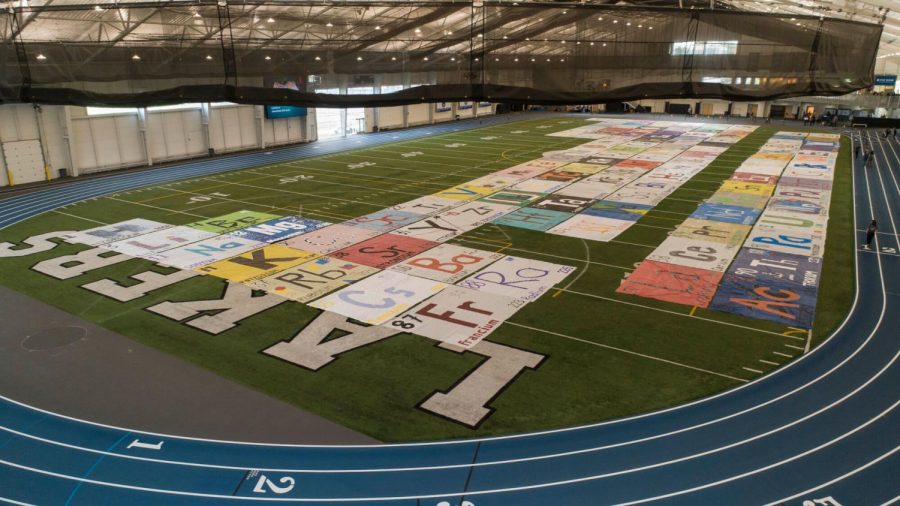GV hosts event for setting new periodic table record
Oct 22, 2019
On Saturday, Oct. 19, the Kelly Family Sports Center at Grand Valley State University saw people gather to see what could be the world’s largest periodic table. Volunteers across Michigan, the United States and the world contributed designs of elements.
Lead Laboratory Supervisor for the chemistry department Michelle DeWitt said she saw an American Chemistry Society (ACS) magazine a few years ago. An article covered the world’s largest periodic table, which she described as not that big. Therefore, she sought to pursue a new world’s largest periodic table.
DeWitt said the United Nations deemed 2019 to be the International Year of the Periodic Table, for this year is the 150th anniversary of the periodic table. Additionally, the ACS plans an event each October for National Chemistry Week. She mentioned the event combined both occasions, celebrating the periodic table and chemistry.
“Everything in the world is chemistry,” DeWitt said.
The periodic table consists of elements present in daily life, not just chemistry fields. DeWitt said elements are what people breathe, including oxygen. She explained elements also extend to comprising food and the human body.
For those attending the event, DeWitt said she wanted them to have a positive experience with chemistry. She mentioned there are people who think about chemistry in negative terms. For instance, Chair of the Chemistry Department Deborah Herrington said those perceptions include seeing chemists as blowing something up or making drugs. Herrington pointed to the show “Breaking Bad” as giving chemists a bad reputation.
During a demo by Gentex Corporation, a boy asked what would happen if certain substances were mixed together. A demo host advised against such random mixtures, even telling this to GVSU students. Instead, he recommended doing research first.
The Gentex demo host demonstrated various applications of chemistry, including testing three gasses for flammability. One balloon popped without fire because it had helium. Two balloons generated fire briefly; one red flame came from hydrogen while a green flame resulted from copper chloride being added to hydrogen. Subsequently, the demo host said hydrogen balloons are not used for birthday parties.
As for element designs, Chemistry Department faculty James Sernard said they are based on themes selected by volunteers. He recalled being president of the Pokémon Club as a GVSU student. Sernard later spoke to the organization about contributing an element, so the Pokémon Club designed polonium with the letter “o” fashioned after Pokémon balls.
Aside from helping with polonium, Sernard said he thought about copernicium’s namesake. After all, Copernicus faced exile by church authorities over his claim that the earth revolves around the sun. Therefore, Sernard said he made a sun theme for copernicium.
Marian Reid, a biomedical science major, said she works for GVSU’s Regional Math and Science Center (RMSC). The office provides outreach for K-12 schools for STEM education. Science is a major part of its resources, and Reid said RMSC knew it would be fun to join the event.
Reid said RMSC designed a sheet for cesium, abbreviated as “Cs.” She recalled the Regional Math and Center interpreted “Cs” to stand for computer science as part of STEM. The design featured glitter upon the element’s name, for Reid said the office researched cesium and learned it is a golden metal.
“I say that our biggest challenge was underestimating how big the element actually had to be,” Reid said.
RMSC teammates used the space across from their office to design cesium. Furniture was pushed to the side. However, Reid said the cesium panel consisted of two sheets sewn together. She recalled how the design reached the legs of seats pushed against walls.
“It’s definitely not a project that you can do the night before,” Sernard said.
Sernard said the biggest challenge was finding the area and time to design elements, involving work such as measuring dimensions. However, he recalled some elements had not completely dried paint. The designs needed to be folded and stored in boxes. When paint stuck together, unfolding panels resulted in it peeling off. This required on-site repairs, Sernard said.
Nonetheless, Sernard said he hopes people managed to relish in taking part in the efforts toward making the world’s largest periodic table record.
“It doesn’t matter if you see it, built it, you know, even glance at it,” Sernard said. “You’re a part of it.”























